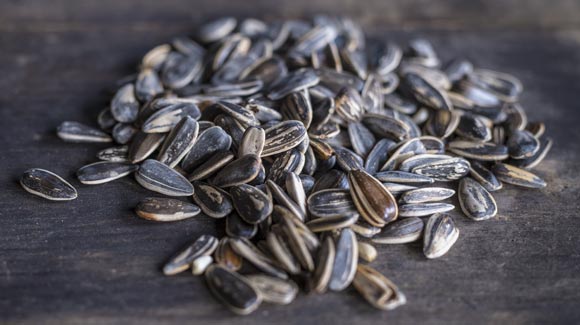隱蔽色的保護傘:警戒性下的片利共生關係
 |
| 用來進行實驗的葵瓜子 photo: P. Allen Smith |
標題:Protection by association: Evidence for aposematic commensalism
摘要
Aposematism is a well known and widely used strategy for reducing predation by conspicuous signalling of unprofitability. However, the increased conspicuousness could make this strategy costly if there are no secondary defences to back the signal up. This has made the elucidation of the evolutionary mechanisms for aposematism and that of the closely-related Batesian and Mullerian mimicry difficult. The present study aims to test whether cryptic and nondefended prey could reduce their predation risk by grouping with aposematic and defended prey. To do this, we used groups of artificial baits that were either cryptic and palatable or conspicuous and unpalatable, along with the corresponding control treatments. These were then presented in mixed and homogeneous treatment groups within a field setting and the local wild bird assemblage was allowed to select and remove baits at will. The results obtained show that undefended non-aposematic prey can benefit by grouping with aposematic prey, with no evidence that predation rates for aposematic prey were adversely affected by this association. These results provide insights into the evolution of Batesian mimicry.
警戒性是一種用來降低被捕食風險的策略,基本上是由警戒色加上次級防禦(化學、物理、行為)才能發揮作用,以演化的角度來看的話,性狀的演化會有些弔詭的地方:警戒色先出現而沒有次級防禦,耗費龐大的演化能量且可能反而吸引目光;先演化出次級防禦而沒有警戒色,無論如何被攻擊率都可能上升,被攻擊沒被吃掉但個體死亡,也會失去把性狀遺傳的可能性;天擇同時作用於兩者身上呢?概率實在太低了。因此在天擇的權衡下,警戒色演化的初期是個很難解釋的迷團。
作者群基於這個疑問,提出一個假設:隱蔽性的個體是否能藉著警戒性個體的保護傘降低被捕食者風險?作者群設計一連串的試驗,以葵瓜子染成紅色跟綠色,以奎寧做為次級防禦的化學物質,將紅色/綠色分別滴上奎寧製造出四種不同的組合,並將其實驗設計為紅色與綠色單色組與混色組,配上不同的數量,以瞭解各種因子的交叉作用。以上實驗都在英國格拉斯哥 (Glasgow) 市郊進行,各地至少觀察到八種不同的鳥類。
結論上來說,如果單純的以防禦機制來看的話,只要有滴上奎寧的組別,無論顏色的被捕食比例都比較低。把綠色(無防禦)比較混色組與單色組的話,會發現混色組的被捕食比例顯著較低,但反過來,綠色(有防禦)的組別不會降低紅色(無防禦)的被捕食比例。無論哪個統計都沒有個體數量上的顯著差異。
 |
| Table 3. 綠色(有防禦)與紅色(無防禦)的Mann-Whitney U-test統計結果 |
真是個雞生蛋,蛋生雞的問題。
此外,本篇的結果以數個難以看懂的表格呈現,請有志同仁務必避免。




0 comments